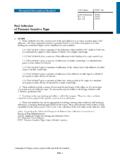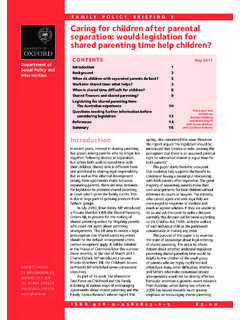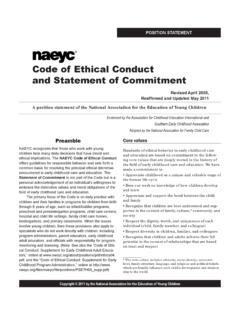Transcription of Stainless Steel Tubing - ASEPCO
1 1 Biotechnology/Pharmaceutical Facilities DesignApril 30, 2001 Stainless Steel Tubing INTHE BIOTECHNOLOGY INDUSTRYBy Michelle M. Gonzalez INTRODUCTION Chemical services of any kind may require special alloys for corrosion resistance, freedomfrom metal ion contamination, or both. Bioprocessing applications can have even more stringentrequirements, due to the high degree of cleanliness required to convey sterile and non-sterileproducts or solutions. Tubing and/or piping systems, must, therefore meet these requirements intheir fabrication, particularly when it applies to their product or solution contact steels are uniquely qualified not only because of their long service life,availability and fabricability, but also because they are non-corroding, non-contaminant, they canbe polished to very smooth finishes, they are strong and rigid, they can withstand heat andchemical sterilization treatments, and they are easily welded.
2 Stainless Steel TYPES There are more than 70 standard types of Stainless Steel and many special alloys. Thesesteels are produced in the wrought form (AISI - American Iron and Steel Institute - types) and ascast alloys (ACI - Alloy Casting Institute - types). Generally, all are iron based, with 12% to 30%chromium, 0% to 22% nickel, and minor amounts of carbon, columbium, copper, molybdenum,selenium, tantalum, and titanium. Following are descriptions of the most widely used stainlesssteels in the chemical processing industry (CPI):Wrought Stainless steels:Martensitic: characteristically magnetic and hardenable by heat treatment are oxidationresistant. Type 410 being the most notable example. These alloys contain 12% to 20%chromium with controlled amount of carbon and other additives. Their corrosion resistanceis inferior to that of austenitic Stainless steels, and are generally used in mildly : characteristically magnetic (because of the ferrite structure) but not hardenable byThis article describes in general terms, Stainless Steel typesand their chemistry, Tubing /piping fabrication standards, andfabrication procedures.
3 It also addresses compliance withbiotechnology and pharmaceutical standards, codes, andguides, as well as surface characterization, electropolishing,joining techniques, passivation, measurement and inspectionfor Cr/Fe ratios, corrosion types, and guidelines for treatment. Contain 15% to as much as 30% Cr, with low carbon content ( ). Thehigher chromium content rates its corrosion resistance as good. Type 430 widely used innitric acid plants is a typical : widely used in bioprocessing, are characteristically non-magnetic, nothardenable by heat treatment, and are the most corrosion resistance of the three many types of austenitic steels include the highly alloyed, the lower alloys in whichMn has been substituted by Ni (the 200 series), and the 18-8 group which includes types304 and 316 and all their variations. Types 304L and, 316L are the workhorse materials ofthe bioprocessing industry, they have their carbon content lowered from about to amaximum of which minimizes the chromium carbide precipitation.
4 These steels donot rust, are easily weldable and machinable, and are not reactive, additive, or absorptive toany extent where strength, quality or purity of the feed is Stainless Alloys:Widely used in pumps, valves, and fittings. All corrosion resistant alloys have theletter C plus a second letter (A to N) denoting increasing nickel content. Numerals indicatemaximum carbon. Typical members of this group are CF-8, similar to 304 Stainless ; CF-8M, similar to 316; CF3M, similar to 316L and CD4M Cu, which has improved resistanceto nitric, sulfuric, and phosphoric Performance Alloys:Because the weaknesses sometimes encountered in the ferritic and 18-8 austeniticgrades 304, 316 and variations thereof, new and better "super" Stainless steels have beendeveloped. These are superferritic grades, duplex grades, and superaustenitic these three, the high-performance austenitic grades have all the weldability andfabricability of conventional 18-8 varieties, coupled with nitrogen induced strengthcomparable to the duplex grades and a very high resistance to chloride pitting and stresscorrosion cracking.
5 The most notable low carbon, high purity superaustenitic Stainless Steel (nickel-based alloy technology) is the 6 Mo (6% Molybdenum) known by its trade nameAL-6XN or "6 Moly" Stainless Steel . Its basic chemical composition being Cr, Ni, Mo, N, C max, and Fe balance, it is the material ofchoice for many modern high performance piping systems, and is available in standardpipe sizes and all commercial sizes of Alloys:The most widely recognized are:200 series, Inco (International Nickel Co.) series, such as commercially pure nickelsNickel 200 and 201, which are widely used in the chemical process series are precipitation and dispersion strengthened low-alloyed series are nickel-copper alloys (non-ferrous alloys), well known as Monel series are the precipitation-hardened 400 alloys, such as Monel series also known as Inconel alloys are nickel-chromium alloys, such as Alloy 625700 series also known as Inconel alloys are precipitation-hardened series are nickel-iron-chromium alloys also known as Incoloy series are precipitation-hardened nickel-iron-chromium series are also known as Hastelloy B - 61% Ni, 28% Mo, Fe, 1% Cr, availableas wrought and cast, resistant to all concentrations of hydrochloric acid at all temperatures,and Hastelloy C - 54% Ni, 16% Mo, Fe, Cr, resistant to all concentrations ofhydrochloric acid at room temperature, wet and dry chlorine, hypochlorite, and noted in the previous descriptions.
6 Corrosion resistance is the paramount concern when itapplies to the proper selection of materials applying to the chemical processing industry at current selection process is an almost continuous progression of small steps, each stepcontaining one or more alloys of increasing corrosion resistance that can be summarized and 316 Stainless steels and their L Stainless steels with higher Mo Stainless steels in particular "6Mo" , Cr, Mo family commonly called the "Alloy C family" based alloys with high corrosion and wear-resistance7. Titanium alloys, referred as chemically pure (CP) CHEMISTRY--Table I -- Chemistry Comparison 304 304L 316 316 LCr (%) - - - - (%) - - - * - (%) maxFe (%)BalanceBalanceBalanceBalanceMo (%) - - (%) maxSi (%) max** max**P %) maxS (%) - ** - (A269)** (A269)** Sulfur has greatest effect on weld quality.
7 Controlling sulfur facilitates orbital field welds by minimizingstabilization problems. Tubing /PIPING FABRICATION STANDARDS Austenitic Stainless Steel Tubing and/or piping used in bioprocessing are producedfollowing various specific industry standards:ASTM A249/ASME SA249 Standard Specification for Welded Austenitic Stainless SteelBoiler, Superheater, Heat-Exchanger and Condenser Tubes - Scope covers pressure tubesmade from austenitic Stainless steels. (Types 304, 304L, 316, 316L, 317. 321, and otheraustenitic grades)ASTM A269 Standard Specification for Seamless and Welded Austenitic Stainless SteelTubing for General Service - Scope covers grades of nominal wall thickness, Stainless steeltubing for general corrosion resisting and low or high temperature service. (Types 304,304L, 316, 316L, 321, and other austenitic grades). Tubing sizes and thicknesses usuallyfurnished to this specification are 1/4" inside diameter and larger and in nominal wallthickness and A270 Standard Specification for Seamless and Welded Austenitic Stainless Steel4 Sanitary Tubing - This specification covers grades of seamless and welded austeniticstainless Steel sanitary Tubing intended for use in the dairy and food industry and havingspecial surface finishes.
8 Tolerances are much tighter than those specified in ASTM A269and ASTM A312, allowing a closer alignment of tube to tube to fittings, which isnecessary for compatibility with automatic orbital welding. Pharmaceutical quality may berequested, as a supplementary requirement. (Types 304, 304L, 316, 316L). Thisspecification covers tubes in sizes up to and including 6".ASTM A312/ASME SA312 Standard Specification for Seamless and Welded AusteniticStainless Steel Pipe - Scope covers Stainless Steel pipe intended for high temperature andgeneral corrosive service. (Types 304, 304L, 316, 316L, 317, 321, and other austeniticgrades). In contrast to sanitary Tubing , industrial piping and components are not compatiblefor sterile service due to their basic design and manufacturing techniques. However, due tothe size limitations of sanitary Tubing , industrial piping NPS (nominal pipe size) must beused in large-scale biotechnology or pharmaceutical facilities.
9 When industrial piping andcomponents are selected, high quality standards must be met, particularly where theirinternal finishes and fit-up is concerned, to assure that piping systems have a minimum ofplaces for product entrapment, and that the systems are sanitizable and A358/ASME SA358 Standard Specification for Electric Fusion-Welded AusteniticChromium-Nickel Alloy Steel Pipe for High Temperature Service - Scope covers pipe usedfor corrosion and high temperature service, normally not less than 8" nominal diameter.(Types 304, 304L, 316, 316L, 317, 321, and other austenitic grades).ASTM A409/ASME SA409 Standard Specification for Welded Large Outside DiameterLight-Wall Austenitic Chromium-Nickel Alloy Steel Pipe for Corrosive or HighTemperature Service - Scope covers pipe with nominal diameter 14-30" in schedules 5 Sand 10S. (Types 304, 304L, 316, 316L, 317, 321, and other austenitic grades). Tubing FABRICATION PROCEDURES There are two categories of tubular products welded and seamless and each has itsadvantages, disadvantages, and share of TubingStarts at the melting operation where special requirements on the alloy are placed tofacilitate welding.
10 The strip from which the tube is made may be supplied as either a hot orcold rolled coil. Cold rolled strip has the advantage of extremely close tolerances, smoothsurface finish (ASTM A480/A480M-00 "Standard Specification for General Requirementsfor Flat-Rolled Stainless and Heat Resisting Steel Plate, Sheet, and Strip"), and excellentmechanical properties. Coils are slit into precise widths and then, put through a sequenceof procedures, which will yield a close tolerance tube. These procedures are:Forming, this includes the use of an entry guide, breakdown rolls, fin rolls, closure , this includes the use of rolls to close the seam, rolls to squeeze during the weld,and rolls to restrain the solidifying weld to prevent bead conditioning, which may be one of two types, weld rolldown, usually for thickerwall tubes, and weld forging for thinner wall , which reduces the oversized tube to the proper diameter, roundness, , which uses two types of cutting to establish the final length: abrasive cutting,which is the most popular since it does not require a die change with each size of Tubing ,5and shear cutting which generally requires a die to contain the tube to prevent deformationduring the TubingMade by piercing, extrusion, and gun drilling of a metal bar.








